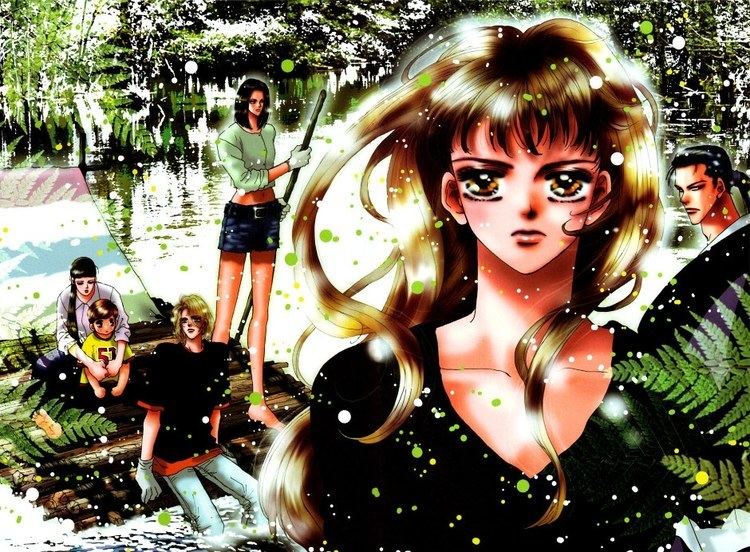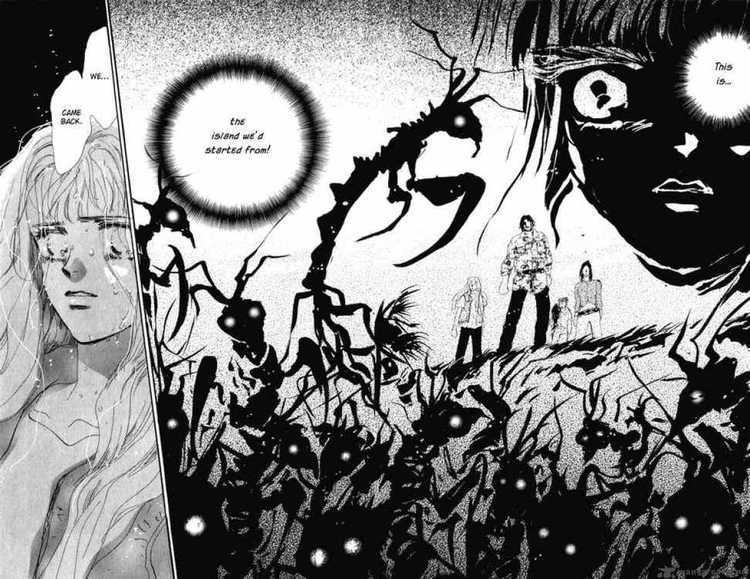 | ||
Original run November 2001 – present Similar Basara, Kaze Hikaru, Machi de Uwasa no Tengu no, Chihayafuru, Cage of Eden | ||
7 seeds animated trailer
7 Seeds (7SEEDS セブンシーズ, Sebun Shīzu) is a Japanese manga series written and illustrated by Yumi Tamura. It has been published by Shogakukan since 2001, first in the magazine Betsucomi, then in Flowers. The series is set in a post-apocalyptic future, long enough after a meteorite hits Earth that new species have evolved, and follows the struggles of five groups of young adults to survive after they are revived from cryonic preservation. The title comes from seven caches of supplies, called "seeds", laid down by the Japanese government. In 2007, the series won the Shogakukan Manga Award for shōjo manga.
Contents
- 7 seeds animated trailer
- 7 seeds going home team summer a
- Story
- Setting
- Development and production
- Songs
- The four seasons
- Manga
- Radio drama
- Reception
- References

7 seeds going home team summer a
Story

When astronomers predict that the Earth will be hit by a meteorite, the world leaders meet to develop a plan for human survival called the Seven Seeds project. Each country will cryonically preserve a number of healthy young people, which will allow them to survive the devastation of the impact. After a computer determines that Earth is once again safe for human life, it will revive each group.

The Japanese government creates five groups of survivors named Winter, Spring, Summer A, Summer B, and Fall. Each group consists of seven members, who are not told about what will happen before they are put in cryonic preservation, and one adult guide who is trained in wilderness survival. These groups are scattered across Japan: the Summer groups in southern and northern Kyūshū, Fall in western Honshū, Spring in central Honshū near Tokyo, and Winter in Hokkaidō. The project also prepares sealed caches containing seeds and instructional books near the "seven Fuji". These seven Fuji are not related to the famous Mount Fuji, but are regional landmarks also named Fuji:

Awoken from the cryogenic sleep many years later, the young men and women find themselves amidst an hostile environment bare of any human life. Their former home country Japan has greatly changed. Completely alone, they can depend only on themselves to survive in the new world.
Setting
7 Seeds takes place an unknown number of years after the collision of a large meteorite with Earth. As a result of the impact, the climate of Japan has greatly changed from what the characters knew from the present day. In the Kansai region there are only two seasons, a dry season and a longer, heavier rainy season. Takahiro of Winter group describes the winters in the northern island of Hokkaidō as being as mild as in Kanagawa Prefecture where he grew up. In addition, sea levels have risen greatly: downtown Yokohama is completely underwater, only the top hand of the statue in Nagasaki Peace Park is above the surface of the ocean. The geography of Japan has changed as well: after an eruption of Mount Aso, Kyūshū has been split into two islands, and the Kansai region is separated from central Honshū by a wide strait. The series depicts a Japan in which, as a result of the new environment and mass extinctions, ecosystems have changed and several new species of animals and plants have evolved.
For example, on the island where Summer group B first lands, off the coast of Nagasaki Prefecture, Botan notes how few of the ecological niches are filled, including no birds or flying insects, and that the limited number of species are still radiating to fill empty niches. In particular, a local rodent resembling a rabbit is in the process of speciation into herbivorous and ravenously carnivorous versions, which are still visually similar. Other dangers new to the characters include swarms of carnivorous white cockroaches and gigantic venus flytraps, sundews, and nepenthes. Species that are unchanged but were previously unknown in Japan include banana trees and crocodiles] Semimaru notes that neither on the island nor on the Kyūshū mainland do they see any ants, bees, or similar insects.
In the Kansai region, Fall group domesticates flightless birds about the size of a chicken and sheep that have grown to resemble llamas, which can be ridden, milked and shorn for wool. Izayoi tells Natsu that a local wasp is deadly, killing with a single sting, and another species has a sting that sickens the victim for a day. According to Akio, corn is the only crop from their seed cache that grows in the area's soils, but Fall group also cultivates a variety of tobacco with a narcotic effect when smoked.
In the southern part of central Honshū, Natsu, Arashi, and Semimaru of Summer group B cross a desert with cactus scrub. Throughout the region they find remains of large reptiles that revive from estivation during the rainy season, which remind Natsu of velociraptors from Jurassic Park. These "dinosaurs", as the characters call them, have grassland and woodland varieties, and during the rainy season are the dominant predator from the south coast to at least as far north as Tokyo.
On the island where the Spring group first lands, off the coast of the Kantō region, Hana notes that there are no vertebrates on land or in the sea, and Momotaro describes the ecology as similar to that of the Carboniferous Era. On land, there are giant insects the characters call "boat beetles" and swarms of bees with stings that are painful but not deadly, which force the group to live on rafts off-shore. In the island's swamps, there are giant praying mantis and giant dragonflies. While at the island, the group lives off shellfish and shallow-water nautiluses, but see no bony fish. The characters find the climate changed as well, as it is too overcast to see the stars for the first two weeks after they are awake, even though it is spring, a season that in the present day is noted for clear weather.
On the mainland of the Kantō region, Spring group meets large aquatic lizards living among the submerged ruins of Yokohama, which hunt in groups. Nearby, in the ruins of central Tokyo, the party from Summer group B is attacked by a giant predatory fish, which Takahiro of Winter group identifies as descended from a deep-sea fish, the only kind of bony fishes to have survived. They also meet a fungus-like growth Takahiro calls "blue mucus", which infects Hana's skin when she touches it. This growth goes dormant in the dry season, and Takahiro realizes it is intolerant to salt and uses it to cure her.
In northern Honshū near Sendai, Natsu, Arashi and Semimaru of Summer group B find the first flowers they have seen during their journey over most of the length of Japan.
In southern Hokkaidō, Winter group encounters grasslands populated by many mammals they do not know, including small-eared rodents, herds of unknown ruminants, and tigers with saber-teeth. They also meet wolves with the ability to project illusions normally used to help hunt.
Development and production
In an author's note, Tamura says that 7 Seeds was inspired by news reports that near-Earth object (89959) 2002 NT7 might potentially collide with Earth.
Songs
Yumi Tamura often includes certain songs into her chapter titles. If there is further info material available, you can find it using the links in the 'manga' table.
There are also songs which don't appear in the chapter titles, but still often play a major role as turning points in the manga. Those are listed below.
The four seasons
A main topic of 7 Seeds are the four seasons, since every team is named after one of them: Spring, Summer A/B, Autumn and Winter.
The team members were chosen into their teams based on which seasons their names matched best.
Almost every 7 Seeds chapter arc is named after one of the 24 solar terms consisting of the 72 pentads (Shichijūni kō). The Rainwater chapter, for example, completely consists of Shichijūni kō.
Manga
7 Seeds is written and illustrated by Yumi Tamura and published by Shogakukan. It began serialization in the November 2001 issue of the monthly shōjo (aimed at teenaged women) manga magazine Betsucomi; in March 2002, it moved to the monthly josei (aimed at young adult women) manga magazine Flowers. Serial numbers have been collected in 33 bound volumes, printed under the Flower Comics imprint. When collected, these serial numbers are grouped in unnumbered parts called "chapters", each focusing on a different group of survivors, with part titles containing a kigo (seasonal word) appropriate for the group name. 7 Seeds was published in French by Pika Édition until 2010.
Radio drama
7 Seeds was adapted into a radio drama that was broadcast from December 9, 2003 to February 6, 2004. The nine episodes were collected on three drama CDs:
Reception
7 Seeds won the 2007 Shogakukan Manga Award for shōjo manga. The series is among the best-selling manga in Japan, having sold more than 10 million. volume 12 reached number 7 on the Tohan best-seller list and volume 13 reached number 10.
